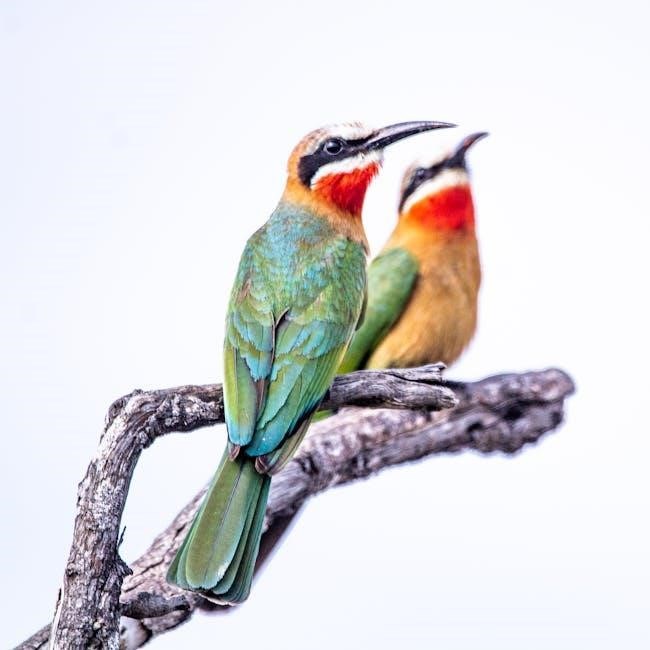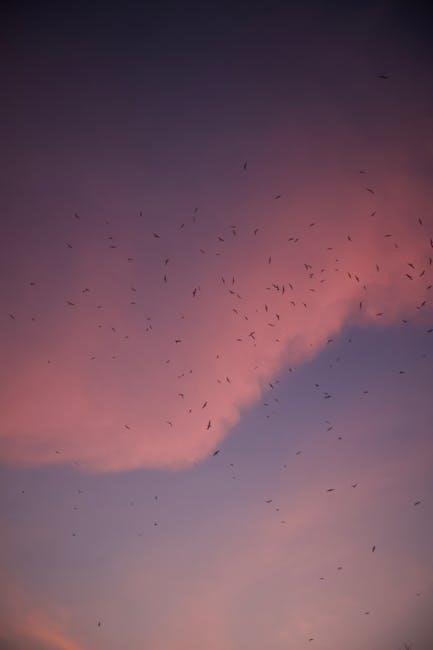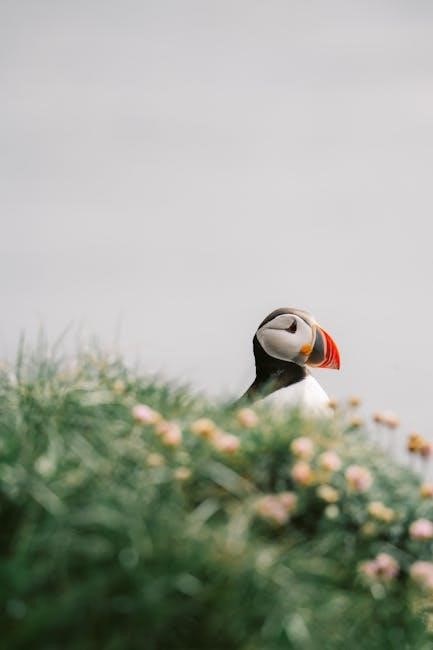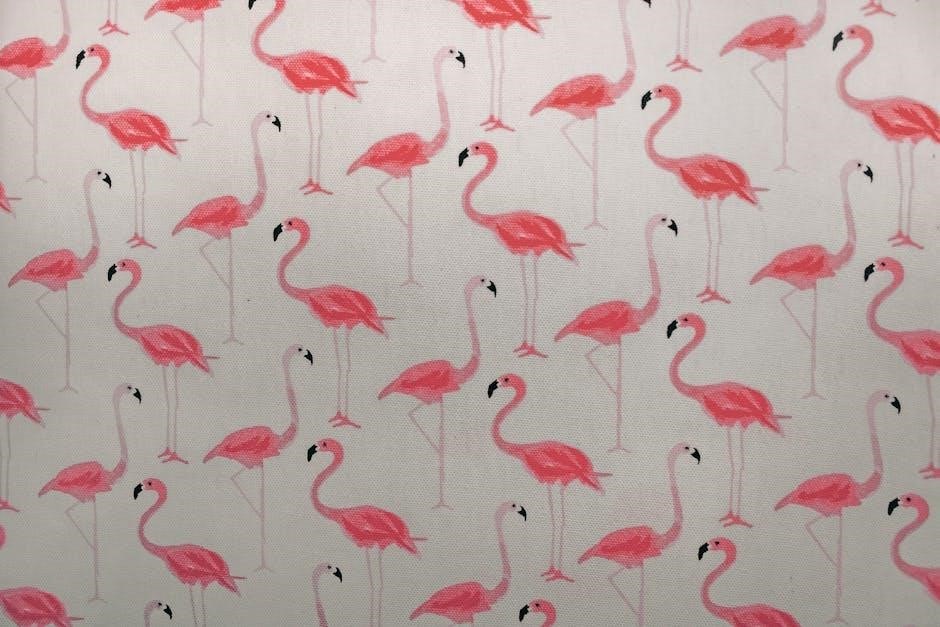Birds’ vibrant colors, as detailed in “How the Birds Got Their Colours,” stem from evolutionary processes and cultural legends. This story explores their transformation from monochrome to dazzling hues, blending science and Aboriginal folklore.
1.1 The Evolutionary Significance of Bird Colors
Bird coloration plays a critical role in survival, reproduction, and adaptation. Vibrant hues often result from sexual selection, where bright plumage attracts mates, while cryptic colors enhance camouflage. These traits evolve to meet environmental demands, ensuring species thrive. The diversity in bird colors highlights evolutionary pressures, such as predator avoidance and communication. Understanding these mechanisms provides insights into how birds adapt to their ecosystems, making coloration a key factor in their evolutionary success and biodiversity.
1.2 Overview of the Article “How the Birds Got Their Colours”
The article “How the Birds Got Their Colours” recounts an Aboriginal legend where birds were once uniformly black. A sick dove’s friends helped it recover, and as a reward, they gained vibrant colors. However, the crow, who refused to assist, remained black. This story, illustrated by Aboriginal children, teaches about gratitude and the origins of bird colors. It highlights cultural heritage and the symbolic meaning of color transformation, blending folklore with educational value for children. The narrative also subtly touches on themes of community and the consequences of one’s actions, making it a charming and insightful tale.
The Evolution of Bird Colors
Bird colors evolved through genetic factors, environmental influences, and sexual selection. Vibrant hues attract mates and aid survival, shaped by pigments like carotenoids and melanin.
2.1 Genetic Factors in Feather Coloration
Genetic factors play a crucial role in determining bird feather colors. Specific genes control the production and distribution of pigments like melanin and carotenoids. For instance, the MC1R gene influences melanin production, affecting color intensity. Carotenoid-based colors are also genetically regulated, as birds cannot produce these pigments internally. Environmental factors, such as diet, interact with genetics to express these traits. Studies on Gouldian finches reveal that genetic mutations can lead to vibrant color variations, showcasing how genetic diversity drives the evolution of feather coloration. These genetic mechanisms are essential for understanding the stunning biodiversity of bird plumage across species.
2.2 Environmental Influences on Plumage Colors
Environmental factors significantly influence bird plumage colors, particularly through diet and light exposure. Birds obtain carotenoid pigments from their diet, such as fruits and insects, which are essential for bright feather colors. A diet rich in these compounds enhances color intensity, while scarcity can dull hues. Additionally, environmental pressures like predation and climate drive evolutionary adaptations in coloration. For instance, birds in sunnier habitats may develop more intense colors due to UV light exposure. These interactions between genetics and environment shape the diverse range of feather colors, highlighting adaptability in avian species. Thus, environmental influences are vital in determining plumage coloration patterns.
2.3 Sexual Selection and Bright Plumage
Sexual selection plays a crucial role in the evolution of bright plumage in birds. According to Darwin, vibrant feather colors often result from female choice, where males with more striking hues are preferred as mates. These colors signal health, strength, and genetic quality, enhancing a male’s attractiveness. For example, carotenoid-based pigments in feathers, obtained through diet, create bright yellows and reds, advertising a male’s ability to secure nutrient-rich food. This selective pressure drives the development of elaborate plumage, particularly in species where mate attraction is critical for survival. Thus, sexual selection is a key driver of the dazzling diversity in bird colors, shaping their evolutionary success.

The Story of Bird Colors
Birds once had dull, monochrome feathers until an injured bird’s friends transformed, gaining vibrant colors as a reward for their kindness, while the crow remained black.
3.1 The Aboriginal Legend of the Injured Bird
In the Aboriginal legend, all birds were once black until an injured bird’s friends helped it recover. Grateful, the injured bird transformed its helpers into colorful creatures. The crow, however, refused to assist and remained black as punishment. This story, detailed in “How the Birds Got Their Colours,” explains the origin of bird colors through kindness, transformation, and the consequences of indifference. It serves as a moral tale, teaching the importance of helping others while illustrating the diversity of bird plumage through a cultural lens.
3.2 The Role of the Crow in the Mythology
The crow plays a pivotal role in the Aboriginal legend as the only bird unaffected by the colorful transformation. According to “How the Birds Got Their Colours,” the crow’s absence during the injured bird’s recovery resulted in it retaining its black plumage. This narrative highlights the crow’s symbolic role as an outcast, emphasizing themes of community, gratitude, and the consequences of inaction. The crow’s unchanging color serves as a reminder of its disconnection from the collective transformation, reinforcing moral lessons about unity and the rewards of selflessness.
3.4 The Gratitude of Birds and the Origin of Colors
The birds’ gratitude for the injured bird’s recovery led to their vibrant transformation. As recounted in “How the Birds Got Their Colours,” the birds that helped were rewarded with dazzling colors, symbolizing their unity and kindness. This act of gratitude marked the origin of their diverse plumage, distinguishing each species. The story underscores the moral of community and the positive outcomes of selflessness, while also explaining the natural diversity of bird colors through a heartfelt cultural narrative.

Biological Basis of Bird Colors
Bird colors arise from carotenoid pigments, melanin, and structural feather features. These biological elements create diverse hues, explaining the scientific origin of their vivid plumage.
4.1 Carotenoid Pigments in Feathers
Carotenoid pigments, derived from dietary sources like fruits and insects, are responsible for vibrant yellow, orange, and red feather colors. Birds cannot produce carotenoids themselves, so they must obtain these pigments through their diet. The absorption and deposition of carotenoids into feathers create striking hues, which play roles in communication and mate attraction. For example, bright plumage in male birds often signals health and genetic quality. This biological process highlights the intricate link between diet, environment, and the evolution of bird coloration, showcasing nature’s ability to produce stunning visual displays through biochemical pathways.
4.2 Melanin and Its Role in Feather Coloration
Melanin, a biological pigment, contributes significantly to bird feather coloration, producing shades of black, brown, and grey. Two types of melanin—eumelanin and pheomelanin—interact to create various tones. Eumelanin is responsible for darker hues, while pheomelanin produces lighter, reddish-brown colors. Melanin is synthesized by cells called melanocytes and deposited into feathers during growth. This pigment plays a dual role in camouflage and thermal regulation, aiding birds in blending into their environments and maintaining body temperature. The distribution and type of melanin determine much of a bird’s appearance, making it a crucial element in avian coloration and adaptation to ecological niches, as explored in evolutionary studies.
4.3 Structural Coloration in Feathers
Structural coloration in feathers arises from the interaction of light with microscopic structures, rather than pigments like melanin or carotenoids. Tiny barbs and barbules on feathers create nanostructures that refract, scatter, or reflect light, producing vibrant hues. This phenomenon explains the iridescent blues and greens seen in peacocks and birds-of-paradise. The precise arrangement of these structures determines the wavelengths of light reflected, creating stunning visual effects. Structural colors are highly dependent on the angle of light, making them dynamic and adaptable. This mechanism is crucial for communication, mate attraction, and camouflage, highlighting the intricate interplay of form and function in avian evolution, as detailed in “How the Birds Got Their Colours.”

Functions of Bird Colors
Bird colors serve vital roles, including camouflage, communication, and mate attraction. These vibrant hues enhance survival, reproduction, and social interactions, as explored in “How the Birds Got Their Colours.”
5.1 Camouflage and Cryptic Colors
Birds use camouflage and cryptic colors to blend into their environments, enhancing survival. Earthy tones like browns and greens help forest birds hide, while pale feathers aid desert species. These adaptations protect birds from predators and assist in hunting. The evolutionary development of such colors ensures birds can rest or fly undetected. This natural concealment is vital for their survival, showcasing how coloration plays a critical role in their ecological success. By mimicking their surroundings, birds demonstrate the remarkable effectiveness of cryptic plumage in their daily lives and habitats.
5.2 Communication and Mate Attraction
Birds utilize their vibrant colors to communicate and attract mates, with bright hues often signaling health, strength, and genetic quality. Males, in particular, display dazzling plumage to impress females, as seen in peacocks and birds of paradise. These displays are driven by sexual selection, where females choose mates with the most striking colors. Carotenoid pigments, obtained from diets rich in fruits and insects, create these eye-catching tones. Melanin, on the other hand, produces darker, more muted shades. This visual language not only aids in mate attraction but also reinforces species identity and territorial boundaries, ensuring successful reproduction and survival.
5.3 Social signaling and Status Indicators
Birds’ colors serve as vital social signals, conveying status, health, and hierarchy within flocks. Brighter, more intense colors often indicate dominance or higher social standing, while duller shades may signal submission or youth. For instance, male birds with vibrant plumage may assert dominance over mates and territories. Additionally, certain color patterns can signal alarm or warn off predators, aiding in group survival. These visual cues are crucial for maintaining social order and ensuring collective well-being, highlighting the intricate role of coloration in avian communication and community dynamics, as explored in “How the Birds Got Their Colours.”

Conservation Implications
Bird coloration studies reveal how environmental changes affect plumage, aiding conservation efforts. Plumage analysis helps track population dynamics and migration patterns, crucial for protecting avian diversity and ecosystems.
6.1 Impact of Environmental Changes on Bird Colors
Environmental changes significantly influence bird coloration, affecting diet, health, and survival. Birds relying on carotenoid-rich foods may lose vibrant hues due to habitat loss or pollution. Climate shifts alter light exposure, impacting structural colors. Feather quality deteriorates with poor nutrition, dulling plumage. Pollution disrupts melanin production, affecting color intensity. These changes impair communication and camouflage, reducing reproductive success. Conservation efforts must address habitat preservation and diet availability to protect avian color diversity, ensuring species adapt to environmental challenges without losing their vital color traits.
6.2 Role of Plumage Analysis in Conservation
Plumage analysis plays a crucial role in conservation by providing insights into bird health, diet, and environmental conditions. Feather coloration reveals carotenoid and melanin levels, indicating nutritional status and exposure to pollutants. Conservationists study plumage to monitor population dynamics, migration patterns, and habitat quality. Changes in feather colors can signal broader ecological issues, such as pollution or climate change. This data informs targeted conservation strategies, like habitat restoration and pollution control. By analyzing plumage, scientists can identify threats early, ensuring effective interventions to protect bird diversity and their vibrant coloration for future generations.
6.3 Protecting Bird Diversity Through Color Studies
Color studies are vital for protecting bird diversity, as they reveal insights into species’ ecological roles and conservation needs. By analyzing plumage, researchers can identify trends in population health, habitat quality, and genetic diversity. Carotenoid and melanin levels in feathers indicate diet and environmental stressors, while bright colors often signal species’ unique adaptations. These studies help identify declining populations and inform targeted conservation efforts, such as habitat restoration and pollution mitigation. Protecting bird coloration ensures the preservation of their evolutionary heritage and ecological balance, fostering a richer, more diverse natural world for future generations.

Scientific Research on Bird Colors
Scientific studies uncover the molecular basis of bird coloration, revealing how genetic factors, carotenoid pigments, and melanin create vibrant hues, aiding in evolutionary adaptations and species identification.
7.1 Molecular Basis of Feather Color Production
Feather coloration arises from molecular interactions involving carotenoid pigments, melanin, and structural proteins. Carotenoids, derived from diet, create vibrant yellows and reds, while melanin produces browns and blacks. Genetic factors regulate pigment deposition and expression, with specific enzymes controlling color intensity. For example, the MC1R gene influences melanin-based colors, affecting traits like redness in some species. Structural proteins in feathers refract light, enhancing hues. This molecular interplay ensures diverse coloration, aiding in communication, camouflage, and mating. Understanding these mechanisms provides insights into evolutionary adaptations and species-specific traits, as detailed in studies on bird coloration and pigment biology.
7.2 Phylogenetic Studies of Bird Coloration
Phylogenetic studies reveal how bird coloration has evolved over millions of years, with specific traits linked to evolutionary relationships. Research, such as that by Stoddarda in 2011, analyzed 559 bird species, mapping coloration patterns across phylogenetic trees. These studies show that bright, carotenoid-based colors often correlate with sexual selection and species divergence. Melanin-based colors, in contrast, are more conserved and linked to environmental adaptations. Such analyses highlight how color traits have emerged and diversified, reflecting ecological pressures and mating behaviors. This genetic and evolutionary perspective deepens our understanding of how birds developed their striking plumage diversity over time.
7.3 Technological Advances in Color Research
Technological advancements have revolutionized the study of bird coloration. High-resolution imaging and spectroscopy enable precise analysis of feather pigments and structural colors. Researchers now use avian vision models to understand how birds perceive colors, revealing insights into communication and camouflage. Additionally, 3D printing and nanotechnology mimic feather structures to study light interaction. These tools, inspired by bird coloration, are also applied in developing optical filters and biomimetic materials. Such innovations not only deepen our understanding of avian coloration but also drive practical applications, bridging biology and technology to explore and replicate nature’s vibrant displays.

Cultural and Educational Significance
The story of how birds got their colors serves as a vibrant teaching tool, inspiring educational activities and fostering creativity while preserving cultural heritage through art and legend.
8.1 The Story as a Teaching Tool
The story of how birds got their colors is a captivating educational resource, fostering creativity and curiosity in children. By exploring the Aboriginal legend, teachers can integrate art, science, and cultural studies, encouraging students to reflect on themes like kindness, gratitude, and community. The narrative simplifies complex concepts, making it accessible for younger audiences while promoting cross-curricular learning. Activities such as illustrating the birds’ transformation or discussing the moral lessons reinforce the story’s educational value, creating a engaging and memorable learning experience that connects students to both nature and cultural heritage.
8.2 Activities for Children to Explore Bird Colors
Engage children with hands-on activities inspired by the story of how birds got their colors. Create a “materials buffet” where kids can craft their own bird illustrations, experimenting with colors and patterns. Organize bird-watching trips to observe natural plumage diversity. Storytelling sessions can follow, where children share their own tales of how birds might have acquired their hues. Art projects, such as painting feathers or designing bird masks, encourage creativity while teaching about color adaptation. These activities not only entertain but also educate children about nature, culture, and the significance of colors in the bird world.
8.3 The Role of Art in Depicting Bird Plumage
Art plays a vibrant role in illustrating the diversity of bird plumage, as seen in “How the Birds Got Their Colours.” Aboriginal children’s illustrations in Broome, Western Australia, bring the story to life, showcasing the transformation of birds from monochrome to colorful. These artworks highlight the cultural significance of the legend while educating about bird coloration. The story’s visual depictions inspire creativity and curiosity, making it a powerful tool for teaching children and preserving cultural heritage. Through art, the tale of bird colors becomes a shared experience, blending education with artistic expression.
The story of “How the Birds Got Their Colours” beautifully blends Aboriginal legend with scientific insights, inspiring future exploration of bird coloration and cultural preservation.
9.1 Summary of Key Points
The Aboriginal legend explains that birds once lacked color, turning vibrant as a reward for aiding an injured bird, except the crow, which refused to help. Genetically, carotenoid pigments and melanin create feather hues, influenced by diet and environment. Sexual selection drives bright plumage for mate attraction, while camouflage aids survival. Structural colors enhance visual displays. Studying bird colors reveals evolutionary adaptations, conservation needs, and cultural significance, emphasizing their role in ecosystems and human stories. This blend of science and folklore highlights the importance of bird coloration in nature and education.
9.2 Future Directions in Bird Color Research
Future research on bird coloration should focus on molecular genetics to uncover genes controlling feather pigmentation and structural colors. Studying how environmental factors like diet and climate change affect plumage hues will provide insights into adaptation. Advanced imaging technologies, such as hyperspectral cameras, can enhance color analysis. Investigating how birds perceive colors differently from humans could reveal new communication strategies. Additionally, conservation efforts should prioritize protecting bird diversity through color-based studies. Education and outreach programs can inspire curiosity and stewardship. By blending science and cultural narratives, future studies will deepen our understanding of bird coloration’s role in evolution and ecosystems.

